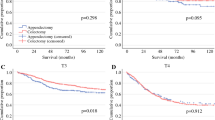Abstract
Purpose: Appendiceal adenocarcinomas are very rare. We analyzed contemporary outcomes associated with surgical therapies for these malignancies. Methods: Retrospective outcomes for patients treated at a tertiary academic medical center from 1981 through 2001 were analyzed. Results: A total of 36 patients (22 females (61 percent) mean age, 52 years) with appendiceal adenocarcinoma were treated. Eighty-eight percent of patients presented with symptoms of acute appendicitis. Eighteen (50 percent) patients underwent curative resection (7 primary right hemicolectomies, 10 appendectomies + subsequent right hemicolectomy, and 1 appendectomy alone). Mean length of follow-up was 55 months. Overall five-year survival rate was 46 percent. The five-year survival rate after curative resection was 61 percent and after palliative surgery was 32 percent (P < 0.05). Among patients who underwent curative resection, factors associated with improved five-year survival rates included histologic type (79 vs. 32 percent for colonic vs. mucinous types, respectively; P < 0.05), T stage (75 vs. 47 percent for T1 and 2 vs. T3 and 4, respectively; P < 0.05), and tumor grade (100 vs. 46 percent for well-differentiated tumors vs. moderately or poorly differentiated tumors, respectively; P < 0.05). Conclusions: Patients undergoing surgery for appendiceal adenocarcinoma can be stratified according to prognostic variables. The role of adjuvant therapies for patients with poor prognostic factors needs to be evaluated in a multi-institutional setting.
Similar content being viewed by others
References
Nitecki SS, Wolff BG, Schlinkert R, Sarr MG. The natural history of surgically treated primary adenocarcinoma of the appendix. Ann Surg 1994; 219: 51–7
Chang P, Attiyeh FF. Adenocarcinoma of the appendix. Dis Colon Rectum 1981; 24: 176–80
Lenriot JP, Huguier M. Adenocarcinoma of the appendix. Am J Surg 1988; 155: 470–5
AJCC. AJCC cancer staging manual. 5th ed. Philadelphia: Lippincott-Raven, 1997.
Kaplan F, Meier P. Nonparametric estimation from incomplete observations. J Am Stat Assoc 1958; 63: 475–81
Hinson FL, Ambrose NS. Pseudomyxoma peritonei. Br J. Surg 1998; 85: 1332–9
McCusker ME, Cote TR, Clegg LX, Sobin LH. Primary malignant neoplasms of the appendix: a populationbased study from the surveillance, epidemiology and end-results program, 1973–1998. Cancer 2002; 94: 3307–12
Cortina R, McCormick J, Kolm P, Perry RR. Management and prognosis of adenocarcinoma of the appendix. Dis Colon Rectum 1995; 38: 848–52
Connor SJ, Hanna GB, Frizelle FA. Appendiceal tumors: retrospective clinicopathologic analysis of appendiceal tumors from 7, 970 appendectomies. Dis Colon Rectum 1998; 41: 75–80
Proulx GM, Willett CG, Daley W, Shellito PC. Appendiceal carcinoma: patterns of failure following surgery and implications for adjuvant therapy. J Surg Oncol 1997; 66: 51–3
Kabbani W, Houlihan PS, Luthra R, et al. Mucinous and nonmucinous appendiceal adenocarcinomas: different clinicopathological features but similar genetic alterations. Mod Pathol 2002; 15: 599–605
McBroom JW, Parker MF, Krivak TC, et al. Primary appendiceal malignancy mimicking advanced stage ovarian carcinoma: a case series. Gynecol Oncol 2000; 78: 388–90
Chen YC, Chiang JM. Appendiceal intussusception with adenocarcinoma mimicking a cecal polyp. Gastrointest Endosc 2000; 52: 130–1
Nascimbeni R, Burgart LJ, Nivatvongs S, Larson DR. Risk of lymph node metastasis in T1 carcinoma of the colon and rectum. Dis Colon Rectum 2002; 45: 200–6
Blumberg D, Paty PB, Guillem JG, et al. All patients with small intramural rectal cancers are at risk for lymph node metastasis. Dis Colon Rectum 1999; 42: 881–5
Gallo JL, Martinez-Ossa R, Ferrer G, Camara M. Mucinous appendicular cystadenocarcinoma and pregnancy. Am J Perinatol 2001; 18: 155–7
Sehouli J, Kopetsch OJ, Ricke J, et al. Primary mucinous adenocarcinoma of the appendix: a rare entity in the differential diagnosis of ovarian cancer. J Obstet Gynaecol Res 2000; 26: 333–9
Ozakyol AH, Saricam T, Kabukcuoglu S, et al. Primary appendiceal adenocarcinoma. Am J Clin Oncol 1999; 22: 458–9
Gough DB, Donohue JH, Schutt AJ, et al. Pseudomyxoma peritonei. Long-term patient survival with an aggressive regional approach. Ann Surg 1994; 219: 112–9
Sugarbaker PH, Chang D. Results of treatment of 385 patients with peritoneal surface spread of appendiceal malignancy. Ann Surg Oncol 1999; 6: 727–31
Smith JW, Kemeny N, Caldwell C, et al. Pseudomyxoma peritonei of appendiceal origin. The Memorial Sloan-Kettering Cancer Center experience. Cancer 1992; 70: 396–401
Ronnett BM, Zahn CM, Kurman RJ, et al. Disseminated peritoneal adenomucinosis and peritoneal mucinous carcinomatosis. A clinicopathologic analysis of 109 cases with emphasis on distinguishing pathologic features, site of origin, prognosis, and relationship to “pseudomyxoma peritonei. Am J Surg Pathol 1995; 19: 1390–408
Author information
Authors and Affiliations
Corresponding author
About this article
Cite this article
Ito, H., Osteen, R.T., Bleday, R. et al. Appendiceal adenocarcinoma: Long-term outcomes after surgical therapy. Dis Colon Rectum 47, 474–480 (2004). https://doi.org/10.1007/s10350-003-0077-7
Issue Date:
DOI: https://doi.org/10.1007/s10350-003-0077-7




